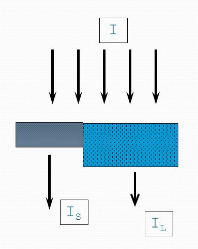SUBJECT CONTRAST
SUBJECT CONTRAST
SUBJECT CONTRAST
It is also called contrast of radiation. The difference in the intensity of the radiography in different parts of the radiography scratch due to the subject is called the subject contrast. The contrast of the subject is the difference in the intensity of the radiograph transmitted through the part of the subject with respect to that transmitted on the other hand.
That is, the difference in the X-ray density produced by an object of the same thickness and the same density in the same x-ray beam is called a subject contrast.
Here, a uniform X-ray beam is incident on a block of thickness equal to muscle (A) and bones (B). Muscle block does not absorb only a few X-ray photons and bone block absorbs most X-ray photons. Now, this attenuated X beam contains a lot of X-ray photons under the muscle and only a few under the bone . The difference in intensity of this X-ray beam because of the subject is called subject contrast.
The contrast of the subject depends on four factors
Thickness Difference
If the same X-ray beam is poured on two blocks in different thicknesses of the same material, they emit X-ray beams in different quantities. Less X-rays pass through a thicker block and more X-rays pass through a thinner block.Density Diffrence
If composed blocks of two different materials of equal thickness are taken, the block with a higher density will allow to pass more X-rays and the lower density block will pass more X-rays. As the Water density in the ice and the water is high, it will suffice to block more X-rays and ice to stop the X-rays of work.
Water blocks 9% more radiation.
Atomic Number Difference
Our body is composed of different atoms, molecules with different atomic weights. Therefore, the effective atomic weight of the X-rays intercepted by different parts of the body depends on the atomic weight of the fabric. The most important part of the photoelectric effect is in this attenuation. The effective atomic weights of certain parts of the body are given in the table below -
The difference between the number of muscle atoms and grease is very lower. For this reason, there is a significant difference in the amount of X-ray beams attenuated by them. Any-kvp energy of energy less than 30 kV can produce the largest difference in EP between grease and muscle.
This is why the Xray KVP is necessary in the radiography of soft tissues such as mammography, because the low-difference atomic number tissues do not produce contrast until the maximum photocelectric effect is produced.
Radiation Quality
The ability of any X-ray photon to affect its fabric depends on its energy. The upper KVP X-rays have more energy. Low KVP Xray produces a high contrast, but the KVP should be so that the room to appear with Xray can be easily distinct (pannetrate).
Generally low KVP X ray gives a high contrast that is called short-term contrast. Because everything is black or white on this movie. The higher Xrays KVPs give a lower contrast to the material that is also called long-term contrast. Because it's a lot of gray ladder between black and white shadow.





Comments
Post a Comment